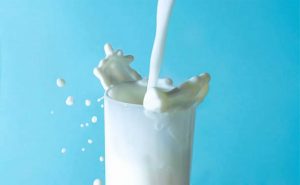When supermarket shoppers reach for white gallon jugs these days, most of the time they grab a low-priced store brand. To expand those offerings, major grocery retailers, including Kroger Co., Walmart Inc. and Albertsons Cos., have built their own milk-bottling plants.
Grocers’ move into the bottling business is threatening some of the biggest operators in the $40 billion U.S. milk industry, the purveyors of national brands. Dean Foods Co., which until last year was the largest U.S. milk processor by sales, and Borden Dairy Co., another big producer, were sold this year after filing for bankruptcy in November and January. Executives of both had blamed some of their struggles on grocers’ focus on cheap milk, often used as a loss leader.
“There are retailers who prefer to have really aggressively low prices on milk because it’s a great way to get people in the stores,” said Tony Sarsam, Borden’s former chief executive. Private-equity firm KKR & Co. and Capitol Peak Partners LLC, an investment firm headed by former dairy executives, bought Borden out of bankruptcy this month.
Adding to the industry’s pressures, milk’s luster has been slowly fading for years in an increasingly crowded beverage market. Many consumers have switched to bottled water and juice, or dairy alternatives made from almonds or oats; breakfast cereal has fallen out of favor.
At the farmer level, about 3,300 dairy-cow herds disappeared in 2019, according to the U.S. Department of Agriculture, following low milk prices, tensions with export customers and processing-plant closures across the country. Wisconsin alone lost about 600 herds over the 12 months up to June 1, the cows typically either sold to another farmer or sent to slaughter. The state led the nation in farm bankruptcies last year.
Although overall dairy demand, factoring in products such as yogurt, butter and cheese, continues to grow, annual per capita U.S. milk consumption has dropped about 40% over four decades.
Faced with the coronavirus and stay-at-home orders, pantry-stocking consumers this spring pushed up milk sales at retail for the first time in a decade. Overall demand dropped as restaurants and hotels closed, according to agricultural lender Rabobank.
For the supermarket chains, milk still has much appeal. They know that shoppers who come for a jug of milk tend to stay and buy a few other items.
Milk still regularly ranks among the top 10 purchases at Walmart’s stores, according to people familiar with operations of the biggest U.S. food retailer.
Dean Foods was one of Walmart’s biggest milk suppliers for decades. Executives of the mega-retailer known for its low prices regularly pushed Dean to squeeze down milk costs.
A Dean milk-processing plant in Louisville, Ky., tweaked equipment to make plastic bottles that weighed 57 grams instead of 60, saving about half a cent on each gallon, said plant workers and labor-union officials.
The Louisville plant was processing as much as 1.2 million gallons of milk a week, 70% of it going to 130 Walmart stores in four states. If hit with a problem such as a big snowstorm, the plant would supply Walmart before other customers. “We did whatever we had to do to make sure we kept them,” said Scott James, who worked as a maintenance technician at Louisville.
Around 2012, Walmart suggested that Dean run a separate bottling plant to produce milk for the chain’s store brand, called Great Value, according to people involved in the discussions. The companies didn’t reach an agreement.
When U.S. milk prices broadly declined in early 2015, Walmart expected Dean to lower its own prices so that Walmart could make more profit on dairy, as often happens with commodity-based products, according to a person close to the discussions.
Dean declined. Gregg Tanner, its chief executive at the time, was preparing to unite Dean’s regional milk brands, such as Garelick Farms and Mayfield Dairy, under a new national label, DairyPure. Dean said it intended to hold the prices of its branded milk where they were.
Walmart dairy managers were skeptical of Dean’s strategy. They believed their customers were differentiating less and less among milk brands — between store brands and premium milks that could cost up to twice as much.
At one point, the price gap slowed sales of Dean’s branded milk so much that Walmart dropped it from some stores. Dean put up billboard ads near Walmarts, hoping shoppers would go in and ask for Dean’s brands, former Dean employees say.
All the while, the dairy farms and milk cooperatives that supply milk to the processors were getting bigger and more professional. By 2017, the eight largest dairy cooperatives were marketing 54% of the country’s milk. To Walmart, buying milk directly from them, then processing and bottling the milk itself, started to look like a feasible cost-saving move.
Walmart announced in March 2016 it would build a milk-processing plant of its own in Fort Wayne, Ind., to supply more than 600 Walmart and Sam’s Club stores in the eastern Midwest.
Dean executives figured the move would siphon away about 100 million of the 2.6 billion gallons a year it sold. Mr. Tanner told investors that Dean’s financial performance wouldn’t be hurt by Walmart’s move into bottling.
Workers at the Dean plant in Louisville took a darker view. “We knew it was the death knell” for the plant, said John Stovall, president of Teamsters Local 783.
At the end of that year, Mr. Tanner stepped down as Dean’s CEO, and operations chief Ralph Scozzafava took over. The new boss paid several visits to Walmart executives. One argument he made was that running a bottling plant wasn’t a good use of the retailer’s resources.
Mr. Scozzafava didn’t respond to requests for comment. Mr. Tanner died last year.
Walmart pushed ahead to finish the plant, and Dean girded for the impact by planning cost cuts. In the middle of 2017, with the volume of its DairyPure milk sold down by an estimated 7.5% over a year, Dean closed a bottling plant in Virginia.
Joe Kelsay, a sixth-generation Indiana farmer whose cows had supplied milk to Dean’s Louisville plant for a quarter-century, opened a letter from Dean in March 2018. It said that Dean was terminating his contract, forcing him to find a new buyer for the milk from his 500 dairy cows.
“It was a bit of a gut punch,” Mr. Kelsay said.
Food Lion, which has more than 1,000 stores on the East Coast, ended its contract with Dean in early 2018 after disagreements over pricing, people familiar with their negotiations said. That cost Dean sales that analysts estimated at another 50 million gallons of milk a year.
Food Lion started purchasing milk from a rival grocery retailer, Kroger, that owned its own milk-processing plants. Kroger, which was early to move into the bottling business, processes roughly 90% of the milk its stores sell.
Dean made plans to close milk-processing plants in Pennsylvania, Massachusetts, Minnesota, Michigan, Illinois and Georgia. Workers at Dean’s decades-old processing plant in Louisville circulated Google Earth images of the Walmart plant under construction in Indiana and joked grimly about how long it was to doomsday, said Mr. James, the maintenance technician.
Before the month was out, Mr. James’s manager gathered workers to tell them the Louisville plant would be winding down.
A few weeks later, Walmart opened its bottling plant in Fort Wayne, adding hundreds of jobs and boosting Indiana dairy farmers who secured supply deals with it.
“This work is an example of how we are always finding efficiencies within the supply chain to deliver on our commitments to everyday low prices and high quality groceries,” said a Walmart spokeswoman, Delia Garcia.
By operating its own plant, Walmart is reducing costs and passing down lower prices to customers, Ms. Garcia said. She added that the retailer’s technology and logistics system cuts delivery time to stores and extends milk’s shelf life.
Mr. Kelsay, the Indiana farmer, and his brother Russ debated what to do with their cows’ milk. Although Walmart’s new facility would buy milk directly from local farmers and cooperatives, farmer contracts had already been signed.
Mr. Kelsay didn’t want to be the one to take his family out of dairy farming after more than 180 years. He hit the phones looking for a milk buyer. One problem was that other farmers who had lost their business with Dean were also looking.
More than a dozen potential milk buyers turned Mr. Kelsay down. Only one offered to buy his milk, and at a price a fifth lower than Dean had paid.
“The glimmer of hope continued to subside,” he said.
In August 2018, Dean reported a quarterly net loss and reduced its financial outlook. Its plant closures now were coming so fast they created new problems. In Lynn, Mass., where the company was winding down a processing plant, milk deliveries rerouted to another Dean plant created logjams.
In February 2019, Dean’s board, meeting before reporting another quarterly loss, voted to explore options including a sale of the company. It attracted offers for parts of its business but held out for a full buyer.
In November, Dean filed for bankruptcy protection. It began sale talks with Dairy Farmers of America, a large milk-producer cooperative, which in February agreed to buy Dean. John Wilson, an executive of the cooperative, said grocery chains that run their own plants often also need milk from other suppliers, including Dairy Farmers of America.
By then, prices of milk were higher, pushing up costs for dairy processors. Supplies were down because thousands of dairy farmers had quit.
Among them was Mr. Kelsay. After failing to find a new buyer for the cows’ milk, he and his brother sold their herd to another farm in November 2018, followed the next spring by their remaining calves and the last of their milking equipment.













